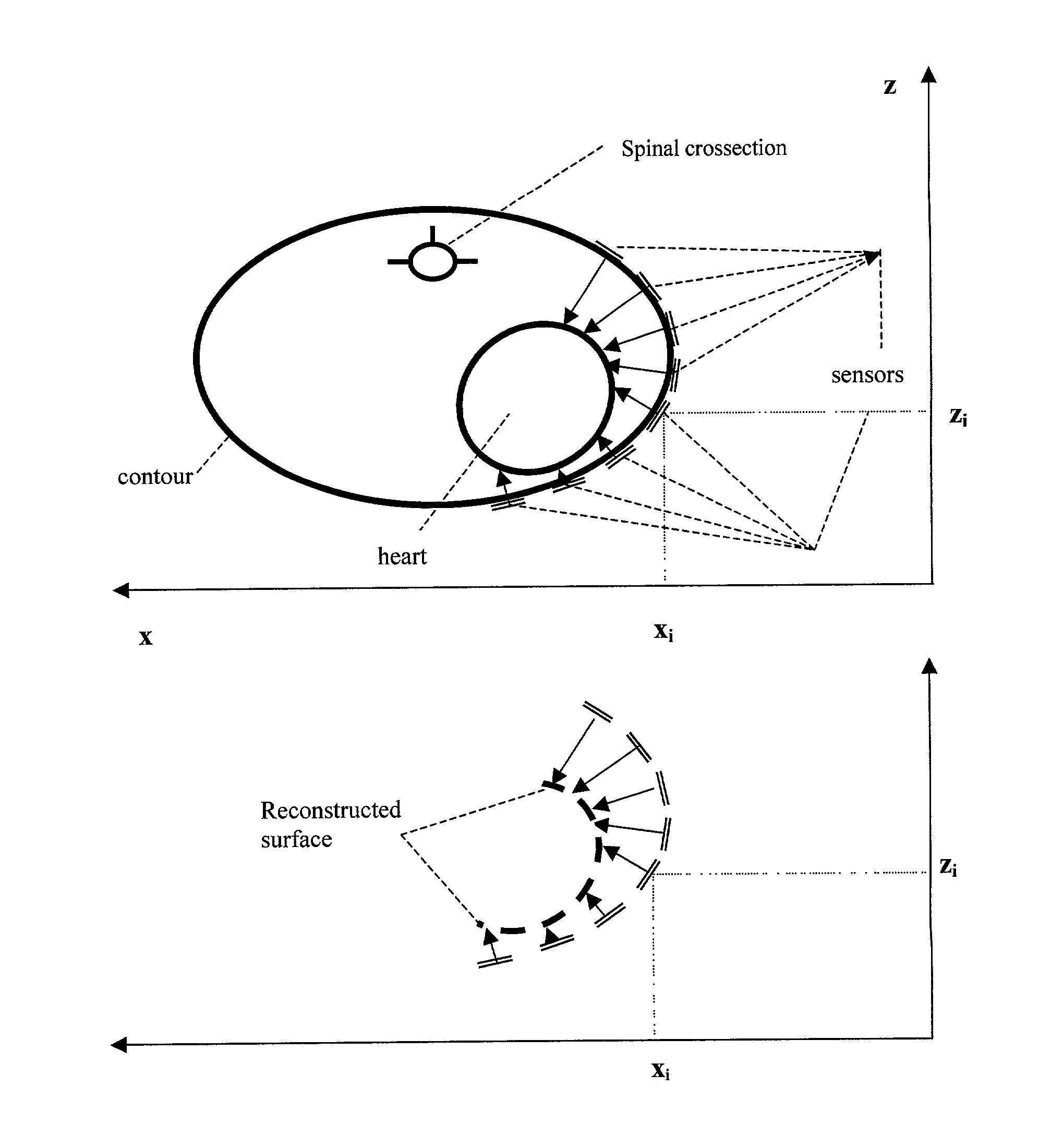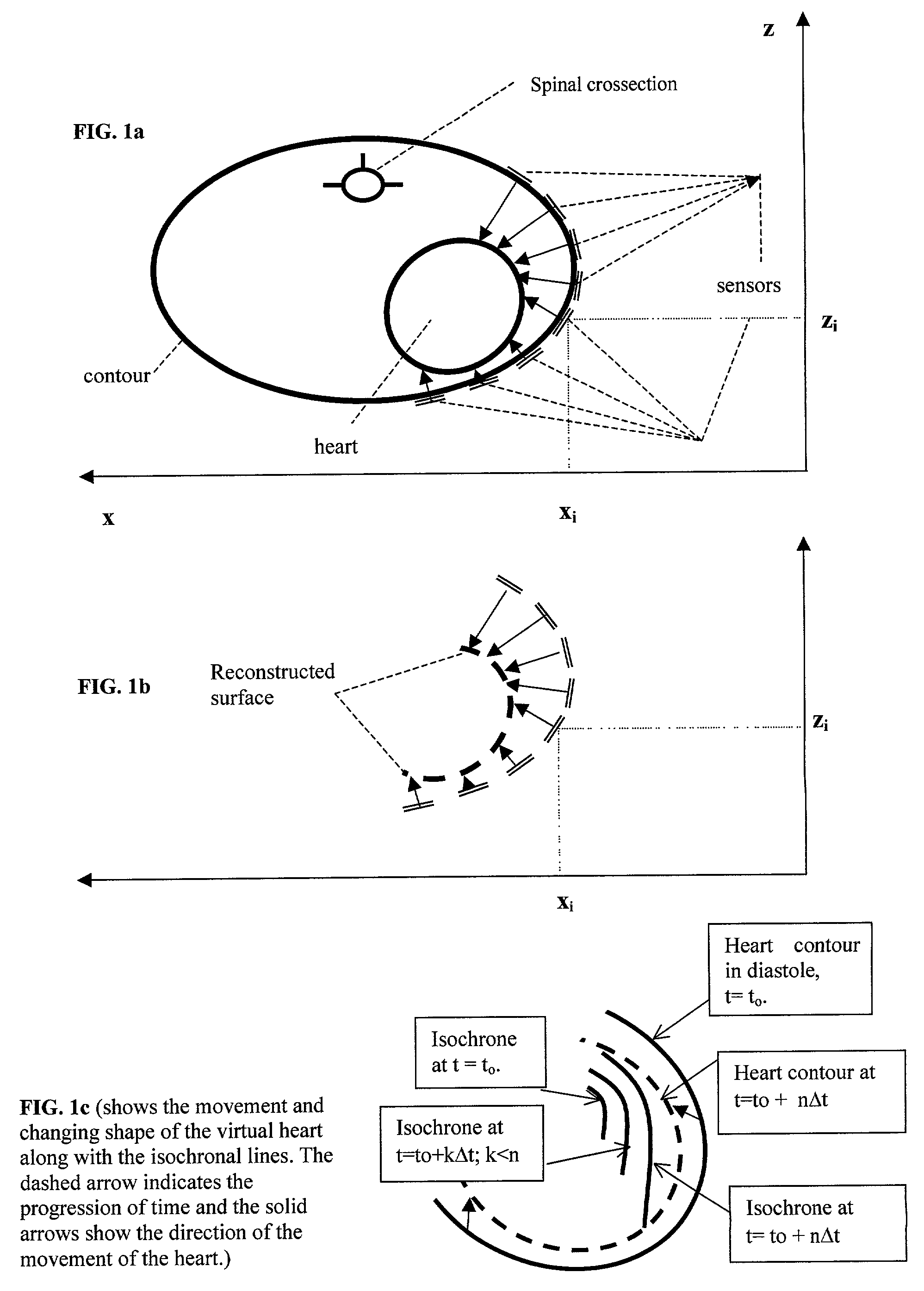[0046]If one relies on the active sensors' far-field discriminatory behavior, then it is possible to postulate sources near the sensor, which will produce similar signals as the naturally produced data. This appears to be realizable if the instantaneous position of the source at the MOA is along the axis of the sensor. The distance from the sensor to the epicardium, the third part of the coordinate set for the
dipole, may be obtained by using
ultrasound. This implies that a partially
open surface image of the epicardium of the left heart may be obtained non-invasively that depicts both the electrical activity and the instantaneous positions of the sources, as applicants expect to be able to provide the spatial information as well. Such a
system provides a novel and economic way for the cardiologist to obtain monitoring and
diagnostic data, as well as
visual guidance in the delivery of interventional therapies, such as
tissue ablation.
[0054]The isochrones are the curves on the chest surface which indicate the connecting line for simultaneously depolarized zones tissue . Their utility may be in detecting zones of delayed
depolarization such as infracted or ischemic areas. The utility of such displays is in diagnosing the site and dimensions of an infarct. The display may also present valuable
diagnostic data about the direction of propagation of the activity as those trajectories are orthogonal to the isochronal lines. Using a smaller number of sensors, such as seven sites, the eighth channel for a Lead II ECG allows combining LECGs recorded in sequence from the same sensors but placed in new locations, as long as it is assumed that the beat-to-beat
rhythm is relatively stationary, within the range of
respiration induced
heart rate variability. This assumption is further justified when
signal averaging is employed for each sensor to improve the
signal-to-
noise ratio (SNR). The trigger for the
signal averaging process can be derived from a fiduciary point of the standard bipolar
surface ECG, such as the peak of the “R-wave” of Lead II. The R-wave is the most pronounced feature of that signal and easy to recognize. Our prior work involved 30 to 60 second long recordings, whose SNR was improved by about a factor of 6 after averaging.
[0055]Another objective of the
system of the present invention is to monitor the mechanical movement of the heart within the chest in its preferred embodiment or in other embodiments, electrically active biological or non-biological sources, especially with respect to the positions of the LECG sensors. The preferred embodiment is described, but the technology could easily be applied for other applications not described or expressed. The distance between the sensor and the closest part of the heart's surface can be monitored with ultrasonic echo detecting transducers. It is assumed that the
speed of sound in the tissues from the
body surface to the heart is known well enough to be able to compute the distance traveled from the time the echo from the heart returns to the
transducer. This assumption is quite reasonable for the frontal and left lateral portions of the heart, based on the anatomic relationship between the heart and the left
lung.
[0062]According to the teachings of the present invention, a display of the electrical activity of the heart as a function of space and time for medical use by a cardiologist is developed. Such display will enable the diagnostician to see whether the electromechanical behavior of the heart is normal, and if it is not, then where and when the aberrant behavior originates and how it propagates. The electrical activity of the heart may be viewed at the
cellular level as the membranes of the
muscle fibers depolarize and repolarize cyclically. The activity may also be viewed as depolarization and
repolarization fronts moving through the heart, separating the tissues into polarized and depolarized compartments. As depolarization penetrates the heart
muscle volume as a
wavefront, the polarized compartment is pushed back, behind the advancing
wavefront. However, after a finite period, typically
ranging between 200 and 400 ms, the depolarized region returns to the polarized or “resting” state, awaiting the next depolarization wave. Cardiac arrhythmias, such as too rapid, too slow, or irregular rates of depolarization and contraction are associated with diseases of the heart and are studied in the
electrophysiology (EP) laboratory by specialists with the aim to understand the aberrant mechanisms and treat those with drugs, devices or by surgical means. The EP studies are usually invasive, that is, electrodes are introduced into the heart or its vasculature to sense local activity. The positions of the sensing electrodes are ascertained by
fluoroscopy. These procedures are very time-consuming and carry a variety of risks. The longer the procedure, the greater the risk for complications. Hence, preliminary information about the propagation of depolarization in space and time, even if insufficient for a definitive diagnosis and intervention, appears to be important in saving time, allowing a
preliminary diagnosis, and reducing the time spent on the invasive study.Directly Obtained Laplacian Cardiac Electrograms (DOLCE)
 Login to View More
Login to View More  Login to View More
Login to View More 


